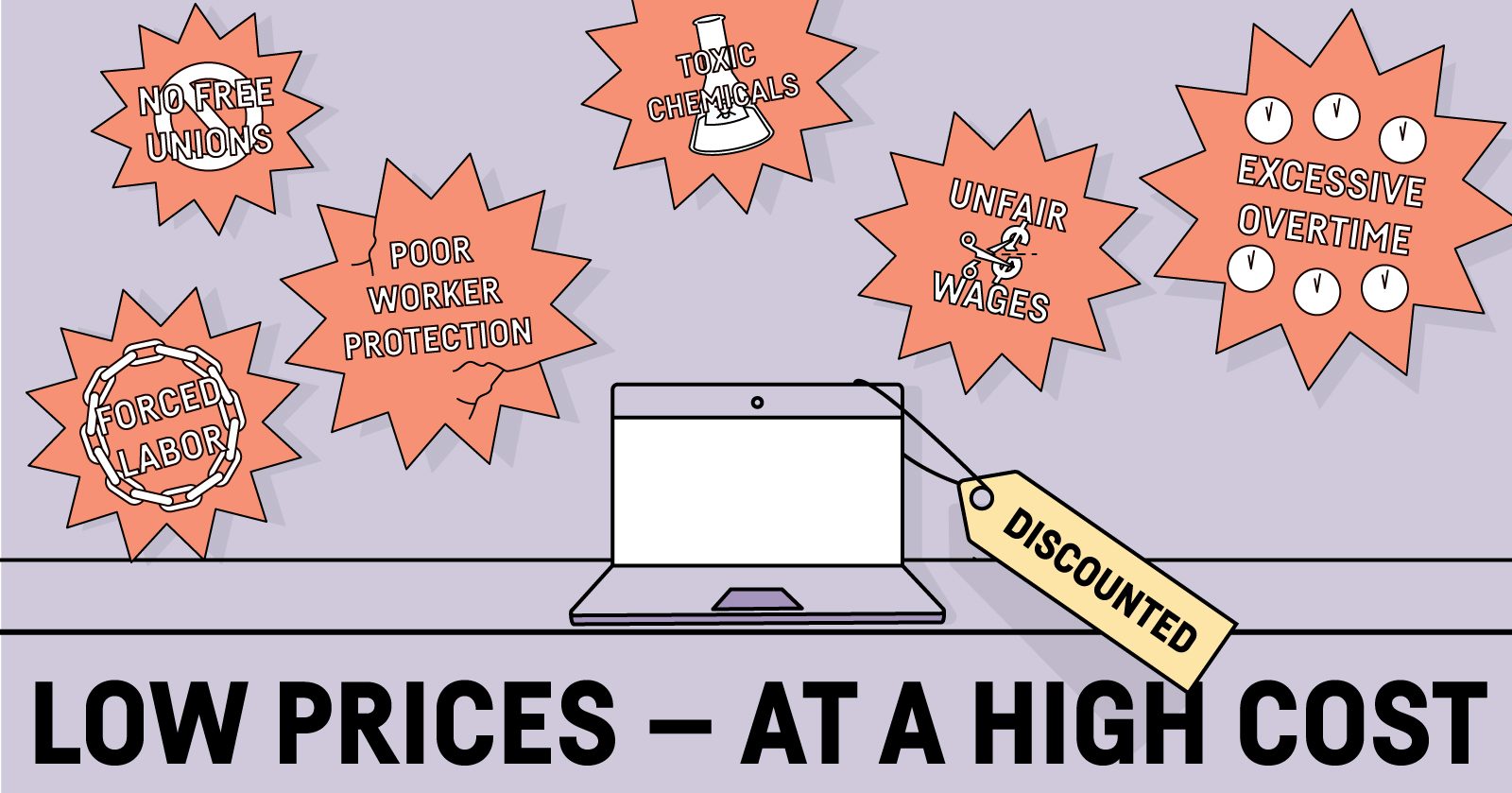Circular solutions help us tackle many of today’s sustainability issues, such as climate change, the depletion of scarce, natural resources, and the destruction of natural habitats. A shortcoming in today’s circularity agenda, however, is that it lacks a focus on social issues.
This is unfortunate from a human perspective, but it also reduces our chances of succeeding with the circular transition. In fact, human and worker rights can be used as leverage to accelerate the pace of change. By stopping the exploitation of people in the IT product supply chain, we can more quickly move toward a production and consumption of IT products that is truly sustainable.
Today, IT products are manufactured and used in a mainly linear way. We take virgin natural resources and make products from them which we then discard once we’re done using them — often after a relatively short time. The products are then replaced by others, made in exactly the same way. It’s widely accepted that the short life we currently give IT products leads to a number of sustainability issues that need to be addressed urgently, such as large greenhouse gas emissions, overconsumption of scarce, natural resources, and enormous amounts of toxic e-waste. In addition to this, short-lived products cause big fluctuations in demand, requiring production to be ramped up, often at short notice. These frequent spikes in production are covered by employees agreeing to excessive hours of overtime, largely because the minimum wage levels they are paid do not provide them with enough income to cover their living costs.
Low prices come at a high cost
One reason why IT products are discarded prematurely is that they are relatively cheap to buy — we pay far from the full cost if the value of natural resources and human wellbeing is factored in. Thousands of people are involved in the production of computers and phones, from the miners who dig up the minerals used in electronic components all the way to the workers in the final assembly factory. Compared to other product supply chains such as textiles, the multi-tiered supply chain of the IT industry dwarfs all others and should really make these products very expensive to manufacture and buy.
This, however, is not the case, and a major reason is that the IT product supply chain contains a high concentration of cheap labor. Much of the manufacturing of IT products is carried out in low-cost, low-wage countries, where workers are often less protected and employment less regulated than in more developed countries. Local governments are known to ignore human rights and established labor laws to stimulate business investment. Wages are kept low, working conditions are sometimes poor, and the abuse of labor rights and social benefits is allowed to continue. In addition, the supply chain is complex and geographically widespread, which makes it difficult to control. A computer or phone contains raw materials and components from hundreds of suppliers, which often are spread over the globe, and with so many actors involved, human rights risks are difficult to manage.
Worker rights helps speed up the circular transition
To buy and manage IT products in a responsible way, you need to take a number of factors into account: environmental, social, and circular. All these issues are linked, in fact, treating workers in the IT industry fairly can help speed up the transition to the circular economy. In meetings with IT product manufacturers, I’ve often heard from factory management that investing in social improvements results in an increase in production costs and a reduction in revenue. It’s not surprising — giving workers a living wage and social benefits will of course increase the cost of manufacturing. However, it is the only reasonable way to go, and apart from the fact that respecting workers’ rights promotes a safer and healthier working environment, it will also make the circular take-make-use-reuse economy all the more possible.
Higher production costs will mean higher purchasing prices, and that is the single most effective way of driving the innovation and development of longer-lasting products that users want to keep, service, and repair rather than dispose of and replace. More expensive IT devices will also be an incentive for IT brands to give more room to circular business models, for instance, product-as-a-service solutions where the IT brand retains ownership of the product and the user pays for the function and value it can offer during a set time period. This way, revenue generation is not exclusively linked to selling as many products as possible. Instead, it makes business sense to manufacture durable IT devices that are designed for a long life, that can be repaired and upgraded so that each product can be leased for as long as technically possible. This is of course a dream scenario for anyone who wants to realize a circular economy.
Purchaser demand sets the process in motion
Enough progress will not happen without demands being made on those with power and influence. Local governments in the manufacturing countries do far too little to enforce their human rights and labor laws, which means that the responsibility falls to manufacturers and brand owners to take responsibility for their supply chains and make sure workers are treated fairly and receive the rights they are entitled to.
Having worked for 25 years with sustainability issues in the IT industry, I know that financial incentives are key to getting brand owners and factory management to prioritize the wellbeing of workers and our planet before short-term economic gains. In conversations with IT brands, I’ve sometimes asked what they consider is needed to speed up the move to more sustainable practices. The reply is almost always: ‘’buyer demand”.
By setting clear, sharp requirements, purchasing organizations can push the industry in a sustainable direction. Criteria need to be relevant, up-to-date, and go beyond legislation. To drive change and reduce the risk of greenwashing, compliance with all criteria should be verified by independent experts. When a non-compliance is found, a corrective action plan should be set up, and implemented within a set timeframe. Regular monitoring is also important to make sure bad practice doesn’t return.
Manufacturing a sustainable product is not just about which product uses the most recycled content or is the easiest to repair. It is the whole life cycle of the product that tells us if it is truly sustainable. How it is made, used, and treated at the end of its usable life. By allowing social considerations within this chain to drive circular development, we can create solutions that benefit both people and the environment in the long term. If we are prepared to pay the true environmental and social costs of our IT use, the circular transition can be made in a way that benefits everyone.

Stephen Fuller leads the development of supply chain and chemical management criteria for TCO Certified. He is the creator of the groundbreaking public accepted substance list for safer chemicals that forces the industry to replace highly toxic substances with independently assessed safer alternatives. Stephen also developed the first social criteria included in an IT product certification, which transformed the scope of TCO Certified from being strictly environmental to also covering supply chain social sustainability.




